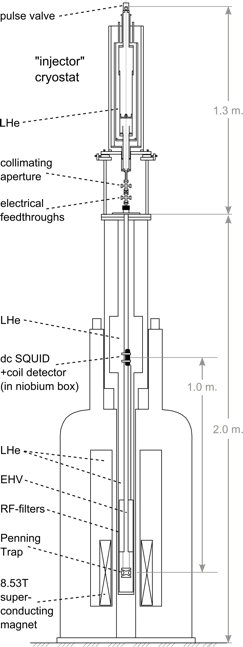Precision Penning Trap Mass Spectrometry
The Florida State University Cryogenic Penning Trap
The FSU precision Penning trap mass spectrometer is shown schematically on the right. The Penning trap electrodes, which are sections of hyperboloids, are placed inside a stable, uniform, 8.5-tesla superconducting magnet. The electrodes are maintained at 4.2K and are biased with a highly-stable precision voltage source. Ions are trapped by the combination of electric and magnetic fields. In the extreme-high vacuum (EHV) inside the trap, ions can remain trapped for several weeks.
Precision atomic mass ratios are obtained by measuring ratios of cyclotron frequencies of pairs of single ions. A single ion is detected by detecting its axial motion which is typically at a few hundred kHz. The oscillating ion induces a femto-ampere current in a high-quality-factor (Q = 30,000) inductor, consisting of a coil of superconducting wire, which is attached to the upper endcap electrode of the trap. This current is then detected using a dc-SQUID. The current induced in the coil also produces a back-EMF. This damps the axial motion, usually on a time-scale of a second. The cyclotron and magnetron motions of the ions are detected and damped by coupling them to the axial motion using RF electric fields. Our usual procedure for measuring the trap-modified cyclotron frequency is known as the Pulse-and-Phase technique. In this method, we first use an rf pulse to produce cyclotron motion (which is typically at a few MHz), with a well-defined initial phase. We then measure the total phase evolved by the cyclotron motion after a period of time, which can be up to 1 minute. The cyclotron frequency is then obtained by dividing the phase evolved by the evolution time.
Because variation in the magnetic field between measurements of the cyclotron frequencies of two ions also causes the cyclotron frequency ratio to vary, it is necessary to alternate between the two ions as frequently as possible. To do this we trap the two ions at the same time. In our usual method, we swap the ions between large and small cyclotron radii. We measure the cyclotron frequency of one ion close to the trap center, while the second ion is “parked” in a 1 to 2 mm radius cyclotron orbit. We then interchange the ions to measure the cyclotron frequency of the second ion, and repeat. An alternative method, which can be used to measure the cyclotron frequency ratio of a pair of ions of similar mass, is to place them in a coupled magnetron orbit. In this case, their cyclotron frequencies can be measured simultaneously. This effectively eliminates the effect of magnetic field variation on the ratio.
Our usual procedure for making ions is to introduce a tiny burst of gas or vapor at the top of the cryogenic extension, which is about 1.5 m above the Penning trap. A small fraction of this gas will enter the trap through the hole in the upper endcap as a molecular beam. At the same time, a field-emission point in the lower endcap (not shown) produces a few nA electron beam which ionizes some of the molecules of the gas. The electron current and duration are adjusted to create a single ion of the desired species in the trap. Unwanted ions are removed by selectively exciting their axial motions, and then reducing the potential of the lower endcap, until the center of the ion cloud is just above its surface. Because the unwanted ions have a large axial motion, they impact and chemically combine with the surface of the endcap. But since the wanted ion’s axial motion has been damped, it avoids the endcap and survives.
Because helium and hydrogen are not well cryogenically pumped at 4.2K, we have recently improved our ion making procedure by installing an additional cryostat on top of the original cryostat extension. This “injector cryostat” is used to inject a pre-collimated beam of gas into the existing cryogenic insert containing the Penning trap. This has enabled us to make ions of 3He, HD and T without spoiling the trap vacuum.

